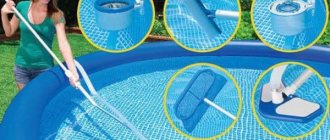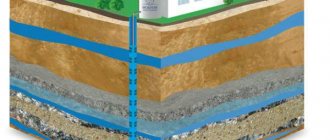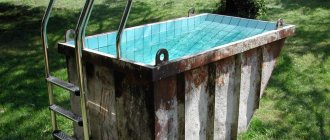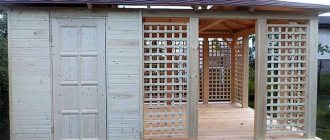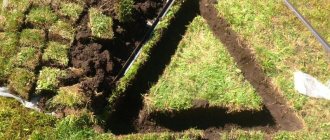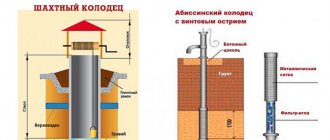Over time, sediment, debris, clay and silt accumulate in the well. To maintain the necessary freshness of drinking water, the owner will have to regularly clean the bottom and shaft. The frequency of the procedure depends on the composition of the water, the type of soil and other features of the area, but cleaning should be carried out at least once every five years. Cleaning a well is not difficult - we will look at the main methods in this article.
Timely cleaning is the key to obtaining high quality water
Cleaning is a necessary preventive measure that allows not only to improve the quality of water, but also to extend the life of the well.
There are several signs indicating that it is time to carry out cleaning work:
- the appearance of an unpleasant odor (most often hydrogen sulfide);
- turbidity of water, the presence of suspended matter that does not settle for a long time;
- shallowing due to the accumulation of a large amount of quicksand;
- entry of foreign objects into the shaft.
Any summer resident can clean a well from bottom sediments, alluvial silt and debris, without even going down into it.
How to understand that a well needs to be cleaned
A well in any summer cottage requires periodic cleaning, regardless of the quality of the structure and the characteristics of the soil. You can understand that it’s time to clean the well in the village yourself based on several signs.
The water in the well became cloudy and darkened
It’s time to clean the well with special devices if the water in it has become dark, cloudy-greenish and brownish-yellow. Most often, such signs appear when the seal between concrete rings is broken and cracks appear. The liquid can also turn green and dark from simple stagnation due to long-term non-use.
If the water in the well has changed its smell and color, you should not drink it.
The water is dirty and there is garbage floating in it
If the well is poorly cared for, or it is not made well enough, then gradually fallen leaves, twigs, and other plant debris accumulate in it. Sometimes you can even find dead animals in the water.
The water has an unpleasant odor
If carcasses of mammals get into the well or if the mine is depressurized, the water may acquire a fetid sewer odor. At the first such signs, you need to start cleaning.
Preventative work
It is recommended to do this up to three times a year: in winter and at the end of summer, when the liquid level drops, but provided that the source is used intensively.
Potassium permanganate, iodine, or another drug described above can be used as prophylactic agents. Some tablets may also be used. But for this you need to read the instructions for their use.
Causes of well contamination
Cleaning the well is a mandatory procedure - it is impossible to use the shaft and not take care of it for many years. There are many causes of pollution, but several main ones can be identified.
Poorly fitting or missing lid
If the mine is constantly open, or its lid does not close tightly, then debris of plant and sometimes animal origin inevitably gets inside. It stagnates and decomposes, which negatively affects the quality of water.
Ideally, it is recommended to equip the well not only with a lid, but also with a canopy
Poorly executed protection against melt water
At the top of any well around the casing ring, a protective layer is required. If it is not there, it is too thin or poorly made, surface water will enter the reservoir every year along with pieces of soil, debris and waste products.
The melt water lock looks like a dense layer of clay around the trunk
Cracks in seam joints
Even if the seams are sealed very well, after the annual frosts they can still crack. Groundwater begins to seep into the well, carrying not only soil particles, but also fertilizers and household waste.
Cracks in well seams inevitably appear; they need to be repaired in a timely manner.
What is the price?
If you are unable to cope with the task, you can contact specialized companies. Approximate prices in rubles:
- cleaning a mine up to five rings deep - about 5 thousand;
- repair and sealing of one seam - about 300;
- waterproofing one seam - about 300;
- source pumping – about 2.5 thousand;
- disinfection with manganese – about 3 thousand.
In any case, the cost will be determined individually, because each case is unique (region, distance from the city, etc.). You can focus on these prices before contacting specialists. As for the work guarantee, it is approximately one year. This is true if the source is not used so intensively. If it is the main source of water, you will have to clean it twice a year.
How to clean a well from silt, sand or dirt with your own hands
There are several methods and devices for cleaning a well. They allow you to automate and significantly simplify labor-intensive work.
How to clean a well with a pump yourself without going down into it
The easiest way to clean a well made of concrete rings yourself is to use a powerful pump designed for pumping out liquid dirt. When choosing it, you need to pay attention to the performance of the device.
To quickly clean a well with your own hands without helpers, it is better to use two pumps and two containers at once, which are installed on the surface of the earth. One of them is filled with water from a well, and then it is supplied back. The end of the sleeve of a drainage device is lowered into the other, pumping out dirt from the bottom. The jet of water supplied during the cleaning process agitates the sludge and improves the quality of work.
When purchasing a pumping device for cleaning a mine with your own hands, you need to take into account the length of the hose
If the first pump, responsible for backfilling the liquid, is left on the surface, then the drainage device is lowered down and fixed approximately 1 m from the bottom surface. A video about do-it-yourself well cleaning devices recommends taking out the unit from time to time to rinse the filter. When it stops getting dirty, the work can be considered completed.
How to properly clean a well at your dacha with a grab
You can clean a well of clay using a grab, which is the name given to a large bucket that is usually attached to excavators or cranes. In appearance, it looks a little like powerful metal jaws with large teeth. A manual device may look exactly the same as an industrial one, or consist of several “petals” with a similar operating principle.
During use, the grab is securely fixed directly above the well, lowered down on a chain or cable until the jaws hit the ground. When the lifting device is activated, the parts of the device simultaneously close, capturing dirt.
The grab is convenient for removing clay and sand from the well
A manual grab allows you to clean the well yourself in a couple of hours. One person can do the job.
How to clean a well with a bailer
You can clear the drainage well of silt using a bailer. This is the name of a hand-held device that you can construct yourself from an iron pipe, a thick washer and a metal ball. Make the device as follows:
- for the device, select a pipe about 60 cm long; its width should be a couple of centimeters smaller than the well shaft in the narrowest part;
- the bottom of the segment is hermetically sealed with a thick washer, and a grate is welded to the upper part;
- a metal ball of such diameter is placed inside the pipe so that it can completely cover the outlet of the device;
- a handle is welded to the top of the bailer, on which a thin cable can be attached.
Cleaning a narrow well using the device is quite simple. On a cable, the bailer is lowered to the bottom, then raised back about half a meter, and then sharply thrown down again. Do-it-yourself drawings for cleaning wells show that the lower hole of the device will open and water and the sand and silt it carries will enter it. The ball, falling down under its own weight, will block the lower outlet and will not allow the sandy-silt mass to flow back.
Cleaning a well with a bailer with your own hands usually takes at least five hours
To fill the bailer at least halfway when cleaning, you need to lower it with sharp movements several times in a row. After this, the device is pulled out and emptied, and then the procedure is repeated.
Manual cleaning of wells
If special devices are not at hand, or they do not give the desired result, you can only resort to manual cleaning. It is necessary to carry out such work with an assistant who will provide backup.
Manual self-cleaning of a well consists of several stages:
- water is pumped out of the mine using buckets or a pump;
- lower down on a safety rope, simultaneously removing dirt from the walls with scrapers and sponges;
- Clean the bottom of the well using a short shovel, putting the sludge into a prepared bucket.
As the container fills, a second person should lift it to the surface and empty it. Also, during the cleaning process, the incoming water continues to be pumped out; for this, you can use the same bucket if there is no pumping device. Otherwise, the liquid will interfere with the quality of scooping out silt and sand.
Do-it-yourself well cleaning with descent allows you to check the condition of the seams
How to clean a well if there is quicksand
In photos of well cleaning you can often see quicksand. This is the name given to a mobile sand or sandy loam layer, saturated with water, which moves and flows under the influence of soil pressure.
You can clean an old well if there is quicksand in the standard way, manually or using devices. But at the final stage of work it is necessary to equip a special bottom shield with your own hands.
To do this, thick wooden boards with infrequent perforations are placed in the well; the device will delay the movement of sand and clay in the water. A special filter is placed on top of the shield - first large, then medium, and then small stones are poured. The overall layer thickness should be at least 15 cm.
When making a shield against quicksand, it is important to remember that it should be slightly smaller in size than the Council mine itself! Since wood decomposes in water over time, the bottom shield will need to be replaced when cleaning approximately every five years.
Selection of equipment: attention to the manufacturer
According to the law, ventilation systems must be cleaned at least once a year. This will ensure a normal level of fire safety in food processing plants and in buildings where dirt and flammable materials accumulate.
Every 5 years, it is necessary to check the condition of the air duct in hotels, restaurants, medical and correctional institutions.
European-made devices
The microclimate in the room and the safety of people depend on the effective operation of the ventilation duct. Thoughtful operation of the system involves regular cleaning of the air duct
When choosing the optimal equipment for cleaning ventilation, you should pay attention to the reliability of manufacturers
The best installations for cleaning ventilation from contaminants are presented on the market by European manufacturers. Market leaders offering a wide range of products are Goodway (USA), Pressovac and AirPower (Finland).
The equipment is of high quality and excellent performance. The downside of the products is their high cost.
Models from domestic manufacturers
A significant portion of consumers choose Russian-made cleaning equipment. It is much cheaper, although the quality of the equipment is impeccable.
When buying Russian equipment for cleaning ventilation, it is better to focus on large manufacturers that offer high-quality, world-class equipment. The products of Equipment for Professionals LLC and Probat Rus LLC are in demand.
Cleaning the air duct does not always help solve the problem; sometimes repairs are required - detailed information on restoring the ventilation system is given in the articles:
- Repair of ventilation systems: analysis of popular faults and ways to eliminate them
- Restoring ventilation: reasons for decreased efficiency and restoration of air ducts
How to clean oil from a well
Oil can get into the well due to a leak in the pumping device, along with groundwater, or as a result of hooligan actions. In any case, if a characteristic film appears on the surface of the water, you must stop using the mine and urgently remove excess impurities from it.
You can do the cleaning yourself in several ways:
- mechanical - oil is collected from the surface of the water using improvised means, for example, ordinary paper, which is subsequently burned;
- chemical - the liquid is treated with adsorbent substances, among which are activated carbon or aluminosilicates;
- biological - the water is saturated with special bacteria that feed on petroleum products.
When using any of the cleaning methods, after removing the oil, you need to rinse the walls of the well under high pressure, while simultaneously pumping out the top layer of liquid.
You can see the oil in the well even without scooping, by the characteristic reflections when illuminated
Hydrodynamic cleaning
In particularly advanced cases, devices like a plunger will not cope; more effective means and methods will be needed. One of these is hydrodynamic cleaning, which is carried out using a hydrodynamic machine for cleaning sewer pipes.
The operating principle of this method is the mechanical treatment of the inner surface of the pipes with a stream of water under high pressure using this machine. Strong pressure sands the surface and removes blockages.
Design and principle of operation of hydrodynamic equipment
The hydrodynamic machine operates as follows: the working body, which has a nozzle, is placed at the beginning of the cleaning section. The compressor is started - an energy device for increasing pressure. From this device, a powerful jet of water flows through a hose under strong pressure, pushing the hose throughout the cleaning area and breaking up all accumulated debris, thereby cleaning the sewer pipes. In this process, a person only controls the direction of the hose and regulates the flow of water.
Types of nozzles for hydrodynamic cleaning
There are several types of nozzles:
- Universal nozzles used to clear common blockages.
- Punching nozzles used to eliminate old and dense formations.
- Bottom nozzles are used to clean storm drains, leaves, sand, and any branches.
- Chain-carousel are used to eliminate dense tumors that have not been eliminated using other mechanical action.
Machine nozzles have direct and reverse action nozzles. Direct ones launch water forward, and from reverse ones diagonally the water moves backward.
Advantages of the hydrodynamic sewer cleaning method
The following advantages of hydrodynamic cleaning of sewer pipes are highlighted:
- complete cleaning of the internal cavity from foreign debris;
- cleaning takes place along the entire length of the pipeline;
- a high-pressure water jet does not damage the walls of the pipeline;
- hydrodynamic cleaning can be used against blockages of any complexity and age;
- cleaning is quick: in an apartment the process will take no more than an hour, in a private house - about 4-8 hours;
- you can work with any pipeline configuration, because with this method there is access to its most difficult and remote sections;
- the owner of a private house can clean not only his own home sewer, but also the storm drain;
- ice plugs will not interfere with cleaning, because they can be easily destroyed by supplying hot water to the pipeline.
This method has only one disadvantage: the need to buy equipment, which is not cheap.
How to clean a well from bacteria
When a well is contaminated, bacteria inevitably appear in it, changing the color and smell of the water. Usually folk remedies suggest cleaning the bottom of the well with lime. To get started you need:
- remove large debris from the mine using a bucket or other devices;
- pump out all the water;
- clean the walls from soft and hard growths with your own hands;
- seal cracks in the seams between concrete rings;
- remove dirt from the bottom of the shaft manually, using a pump or other special devices.
After this, prepare a 3% bleach solution at the rate of 500 ml of product per 1 m2 of surface. The walls of the well are treated with a thick mixture, and then washed under pressure several times.
Then the water itself is cleaned with chlorine:
- 20 g of 1% lime powder are diluted in 1 liter of cold liquid, the volume of the well is determined and the amount of solution is selected depending on it. On average, 400 ml of product is needed per 1 m3 of water.
- The disinfectant liquid is prepared in the required volume, poured into the well and mixed for ten minutes with a long pole.
- The well is covered with an opaque lid from above and left for 6-10 hours.
After time, the water is completely removed from the well several times with a bucket or pumping device until the specific smell finally goes away.
How to clean a well with potassium permanganate
To clean the well from bacteria, you can use a solution of potassium permanganate. Pour a large spoonful of powder into a bucket of warm water, stir, and then pour into the well and leave for an hour. The walls of the shaft should also be wiped with a brush soaked in potassium permanganate.
After the expiration date, the water is pumped out several times in a row. After the final procedure, a metal sieve with 5 g of manganese powder is lowered to the bottom. A simple device will allow you to make clean water in the well; the product will ensure constant disinfection of the incoming liquid.
When disinfecting a well, it is important to carefully treat the walls; mold and bacteria accumulate on them
Methods for cleaning wells using equipment
The following cleaning methods are currently used:
- cleaning with a suction pump;
- vacuum pumping;
- hydrodynamic cleaning;
- chemical washing;
- thermal washing.
Cleaning with a suction pump
From the point of view of convenience and efficiency, the most optimal option is to use a suction pump. This equipment is intended for sewerage work. Its design includes a tank and a vacuum pump. One of the advantages of this method is the ability to use it in any season. Sludge suckers are widely used for various types of cleaning and preventive work, including for removing sludge from concrete and plastic sewer wells and networks, settling tanks of treatment facilities, septic tanks, as well as for transporting liquid waste.
Cleaning with a suction machine
Vacuum pumping
This method involves cleaning the well and pumping out wastewater using a powerful vacuum pump. After this, the waste is collected and disposed of. This type complies with environmental safety standards and is an effective way to maintain optimal sanitary conditions.
Pro tip:
To ensure stable operation of the sewer system, prevent emergency situations, and maintain the required level of sanitation, it is necessary that sewer wells be pumped out regularly.
Machine for vacuum pumping of sewerage: appearance and diagram
Hydrodynamic cleaning
The operating principle of hydrodynamic cleaning is to wash away waste from the internal walls of a sewer well with strong water pressure. In this way, you can eliminate any blockages of organic and inorganic origin. After flushing is completed, the waste is collected and disposed of.
To carry out such cleaning, one or two machines can be used, depending on the amount of deposits:
- the first is a sewer cleaning machine;
- the second is a silt sucker.
Sewer jetting machine and suction pump
The use of the latter is advisable for large volumes of sludge. To illustrate the need to use a suction pump, consider two examples:
- Example No. 1: a pipe with a diameter of 500 mm and a length of 100 m is heavily clogged. The volume of precipitation averages 200 cubic meters. m. To eliminate them, a suction pump is required.
- Example No. 2: a pipe with a diameter of 150 mm and a length of 100 m contains 2 cubic meters. m of precipitation. Naturally, in this case you can remove the blockage manually.
Pro tip:
Hydrodynamic cleaning is universal, but its effectiveness is achieved only if cleaning work is carried out regularly. This allows you to ensure uninterrupted operation of the system and prevent emergency situations.
Scheme of hydrodynamic cleaning of sewer wells
Chemical washing
This method involves the use of potent chemical reagents. With their help, it is possible to soften and transform condensate deposits of various origins, including salt deposits, into a dissolved state. The process is carried out using special equipment and foamed chemical composition. The latter makes it possible to effectively treat surfaces with a negative plumb and specifically concentrate the impact of reagents. In addition, the foam also creates a mechanical effect.
Chemical cleaning of sewer wells is very effective and environmentally friendly, but due to its high cost it is rarely used.
Chemical wash agent
Thermal wash
In its principle of operation, this method resembles hydrodynamic cleaning. But its fundamental feature is the use of hot water pressure. The water temperature can range from 120 to 160 degrees. An indispensable condition for the effectiveness of this method is its regular implementation. It is noteworthy that in combination with thermal and chemical washing it is possible to increase the efficiency of the latter several times.
How to clean water in a well
The quality of well water can be seriously affected by impurities in the soil. It is often impossible to eliminate the reasons for the appearance of unnecessary connections inside the well with your own hands. But it is quite possible to clean the liquid using simple devices.
How to remove lime from well water
If water supersaturated with lime comes from a well, the easiest way is to subject it to a settling procedure. Using a bucket or pumping device, the liquid is simply drawn into an open container and left in a calm state for a day. Large fractions will settle to the bottom under their own weight.
Another reliable DIY cleaning method involves running water through a semi-permeable filter. The most inexpensive and effective sorbent is activated carbon. Such a filter in a cleaning device will need to be changed frequently, but it will be able to retain about 95% of excess particles.
The filter system for well water eliminates the need to wait for the liquid to simply settle.
How to clean rusty water in a well
One of the most common problems faced by well owners is the increased iron content in the water. If the element is trivalent, that is, insoluble, then the liquid will initially have a reddish tint.
Rust naturally precipitates, so you can clean cloudy well water in the same way as if you have too much lime. The liquid is first fed into a large container, where it settles for about 12 hours, and only then is used for drinking and household purposes.
Rust in water appears due to the characteristics of the soil - it is impossible to completely eliminate it in a well
You can also use filtration if it is urgent to supply water from a well to communications. In front of the water supply, devices for rough cleaning, cartridge or sorption elements are installed, which will filter out large and small rusty particles.
How to remove iron from well water
Sometimes well water looks completely clean and clear, but has a metallic taste and turns rusty after settling. This means that it contains divalent soluble iron, which becomes noticeable only during the process of gradual oxidation.
To clean water from such an impurity with your own hands, it is necessary to accelerate the transformation of the element into an insoluble precipitate. The most reliable way is aeration:
- A submersible pumping device is installed in the well, pumping liquid into the barrel on the surface, and a plastic bucket with a watering nozzle in the center is fixed on top of the container above the perforated lid.
- Contaminated water under pressure flies out of the watering can, breaking into small drops. Then the liquid flows down the walls of the bucket and through the holes enters the storage barrel, and from there, after cleaning, it enters the water supply system. The iron sediment remains at the bottom of the container.
When leaving the watering can, water with a high iron content is actively saturated with oxygen and oxidized
Precautionary measures
If the surface of at least one of the concrete rings shows signs of contamination, deposits, or changes in color, it needs to be cleaned as soon as possible. This can be done at any time of the year, even in winter
But it is important to remember that cleaning wells is a much more serious procedure than going to the store or riding a bicycle. At least three people must start work at the same time
When descending into the well, they must be tied with a safety rope.
Before going down, it is worth checking whether dangerous gases have accumulated below. This is done by lowering a bucket containing a burning candle; deviation of its flame to the side, extinction or change in color of the fire indicate danger. Experienced specialists always go down wearing a helmet and wading rubber boots. For those suffering from heart and vascular diseases or periodic dizziness, it is better not to climb into wells, especially if the depth exceeds 3 m. You should definitely get a rope or simple ladder, having first made sure of their reliability.
In such a situation, as well as when the well is saturated with carbon dioxide and toxic fumes, it is better not to try to do the work on your own. It would be much more correct to call qualified specialists. It is not recommended to stand at one point for a long time; this may result in your legs being sucked in. It is recommended to place a wooden platform in case of muddy or waterlogged soil, this will help distribute the weight evenly.
Unless absolutely necessary, it is better to refrain from cleaning the well in the dark. If you notice objects falling from above, including tools, it is better to press yourself against the wall. You can only be downstairs alone.
It is advisable to limit the time you work on the bottom to 15 minutes with rest at the top for at least the same amount of time. If it is necessary to illuminate something, only special lanterns are taken into the well, which are made according to an explosion-proof design. They must be turned on and off strictly before and after descent. It is strictly forbidden to smoke or drink water downstairs. Do not trust well cleaning to minors.
For more information on how to clean a well with your own hands, see the following video.
Security measures
When cleaning a well with and without accessories, precautions must be followed. Namely:
- do not go down into the mine without backup and an assistant;
- after pumping out the water, first lower the container with the burning candle; if the latter goes out, there are gases at the bottom that are dangerous to humans, and cleaning must be done in a gas mask;
- perform chemical disinfection with your own hands wearing a respirator, gloves and safety glasses.
Only a person without cardiovascular diseases, hypertension and asthma can clean a silted well. If a well owner suffers from chronic illnesses, he needs a healthy assistant. At the bottom of the mine there is less oxygen in the air than at the surface; during cleaning, this can provoke dangerous attacks of suffocation.
Well cleaning with and without equipment is carried out only during the daytime
Briefly about the main thing
The labor-intensive procedure for cleaning a well requires the participation of specialists, but if you want to save on calling the special services, you can do everything yourself. To do this, you will need special tools that can be used to remove various types of deposits.
You should remember about the hygiene of using a well, because often the water source is polluted precisely because of the human factor. It is important to be careful.
When cleaning your well regularly, you need to familiarize yourself with the safety rules to avoid injury. And between procedures it is recommended to resort to preventive measures.
Ratings 0
Grab drawing
A homemade grab is a device that is structurally similar to a large mechanized grab. It differs from the latter only in its small size and the absence of a machine drive.
The purpose of a hand grab is to clean wells from deposits of silt and bottom debris. It is unsuitable for digging soil due to the low force on the closing buckets.
Rules for using a hand grab
To conveniently work with a homemade device, it is recommended to follow a number of simple rules:
- When descending, the main chain can be wound around the lifting mechanism, the short chains are controlled manually.
- The grab is lowered into the well with the buckets open. Using a winch, the device is lowered to the bottom of the structure.
- After reaching the bottom, the device is raised using the central chain. In this position, the buckets close, capturing part of the soil with silty deposits and bottom mud.
- After lifting, the device is thoroughly cleaned of dirt. The lowering/ascent working cycle is carried out until the hydraulic structure is completely cleaned of contaminants.
- After completion of work, the grab is cleaned and dried. To avoid corrosion on steel elements, it is better to store the device in a dry and well-ventilated place.
Advantages of plastic products
Despite the disadvantages, plastic pipe products have many advantages. On its walls, deposits begin to accumulate to a much lesser extent compared to similar products made from other materials.
As a result, the drain cleaner may not be needed for a long period. The fact is that plastic products have a low roughness coefficient (resistance to moving flow).
This parameter represents the size of the recesses and protrusions present on the walls of the pipes. For concrete, this characteristic in millimeters is 1.22; for asbestos cement – 1.15; for cast iron – 0.47 and for plastic – 0.02.
Over time, the value of the roughness coefficient changes. After a five-year period of operation of the cast iron system, it can reach 5 millimeters, and after 15 years – about 25 millimeters. This large value is about 50% of the internal diameter of the pipeline. As a result, you have to use the sewer pipe cleaner much more often. But you need to know what type of equipment is best to use in a given situation.
Rules for using a hand grab
To conveniently work with a homemade device, it is recommended to follow a number of simple rules:
- When descending, the main chain can be wound around the lifting mechanism, the short chains are controlled manually.
- The grab is lowered into the well with the buckets open. Using a winch, the device is lowered to the bottom of the structure.
- After reaching the bottom, the device is raised using the central chain. In this position, the buckets close, capturing part of the soil with silty deposits and bottom mud.
- After lifting, the device is thoroughly cleaned of dirt. The lowering/ascent working cycle is carried out until the hydraulic structure is completely cleaned of contaminants.
- After completion of work, the grab is cleaned and dried. To avoid corrosion on steel elements, it is better to store the device in a dry and well-ventilated place.
Even a novice and inexperienced master can construct a grab for a well. All that is required for this is a great desire, free time and the ability to work with welding equipment.
Pump for cleaning wells: selection criteria and operating rules
Previously, work on cleaning the well bottom was carried out exclusively by hand using buckets and ropes. Now pumping equipment helps to cope with this problem. Using technology, the cleaning procedure is much simpler and much faster. Do you agree?
We will tell you how to choose the ideal pump for cleaning wells, capable of pumping water containing sand and fine gravel. Here you will find out whether the borehole or drainage model will better rid the mine of silt and mineral deposits. You can choose the most efficient equipment.
The article we have proposed describes in detail the technologies for cleaning a well shaft using different types of pumps. For visual perception of information, diagrams, photo collections, and video instructions are attached to it.
A simple solution from time immemorial
If you water your garden by connecting a hose to the central water supply, then your electricity and water bills are unlikely to add to your good mood.
What is the way out of this?
Of course - a well or a well (what price to choose a deep-well pump for a well), where there is always water, moreover, in unlimited quantities.
If the spring is used irregularly, over time this leads to the fact that the quality of the liquid becomes unsuitable for drinking.
There are two ways out of this situation:
- do nothing, accept what you have and use water only for household needs.
Or you can do a general cleaning of the source of life-giving moisture.
If you turn to professionals for help, they will do everything very quickly and efficiently, but they will charge a lot of money for their work.
The high cost for such work is completely justified. Many ordinary people think that this activity is not worth such an investment.
And they are right. Why pay your cash, earned through back-breaking labor, if you can try and clean the source of dirt without outside help.
Others do not want to realize the importance of this procedure and put off this activity “for later.”
Do you know how to connect a cast iron sewer pipe to a plastic one? The most popular methods of installing a system with your own hands are described in this useful article.
Read on this page which is the best instantaneous water heater for your dacha.
But this is a wrong position . Since over time the situation will only get worse and soon you will have to completely forget about clean water.
It is necessary to carry out the work of cleaning the bottom of the well on your own, taking into account the background of the blockage.
2How to choose equipment for cleaning the sewer system?
The choice of type of cleaning equipment largely depends on the material from which the pipes are made. Thus, a hydrodynamic machine is most effective for carrying out cleaning work in plastic pipelines and, if necessary, complete thorough cleaning of internal surfaces.
The process of hydrodynamic cleaning of a sewer system consists of supplying a powerful jet of water from a flushing head into the flushed pipeline under the influence of high pressure. This method allows you to completely clean the internal walls of the pipeline and remove almost any blockage.
To clear mechanical blockages - in cases where it is necessary to remove various debris from the pipe - branches, leaves, rags and other clogging elements, it is more effective to use a mechanical cleaning machine.
In mechanical installations, sewer contamination is removed using a cleaning cable. It can be made in the form of long metal rods (rod), a spiral twisted into a drum (drum) or a stacked spiral consisting of various sections (sectional).
BY THE WAY. Additional attachments are a guarantee of expanding the areas of application of the cleaning machine.
In addition to the intended purpose, the nozzles of cleaning machines are also divided by size and materials used for their manufacture.
